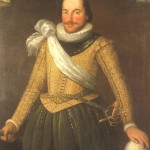Sir Thomas Button was a great sea-farer who is connected to Cadoxton by marriage when his brother’s daughter married Nicholas Andrew of Cadoxton Court, West-Barry probably in the first half 1600AD. Sir Thomas Button in 1613 was the admiral of the king’s ships on the coast of Ireland, and on the 30th of August 1616 he was knighted by Sir Oliver St.John, lord deputy of Ireland.
Sir Thomas lived for a short time in Cardiff but died in London on 6th April 1634 and was buried at St. Margaret’s in Westminster London on the 8th August of the same year.
He was one of Glamorgan’s famous sons. The Button family were long settled in the County, having been associated with many local families including the Andrew family of Cadoxton Court. He would no doubt have visited the court as members of the Andrew family were mariners in the 1590s and The Court was situated in a strategic position overlooking and close to the Bristol channel.
In April 1610 Henry Hudson left England aboard the ship Discovery. He and his crew, which included his son John, made their way across the Atlantic Ocean. After skirting the southern tip of Greenland, they entered what became known as the Hudson Strait. The exploration then reached another of his namesakes, the Hudson Bay. Traveling south, Hudson ventured into James Bay and discovered that he’d come to a dead end. By this time, Hudson was at odds with many in his crew. They found themselves trapped in the ice and low on supplies. When they were forced to spend the winter there, tensions only grew worse. By June 1611, conditions had improved enough for the ship to set sail once again. Hudson, however, didn’t make the trip back home. Shortly after their departure, several members of the crew took over the ship and decided to cast out Hudson, his son and a few other crew members. Mutineers put Hudson and the others in a small boat and set them adrift. It was believed that Hudson and the others died of exposure sometime later, in or near the Hudson Bay. Some of the mutineers were later put on trial, but they were acquitted.
In 1612 Button was given the command of an expedition of two ships—the Resolution and the Discovery—to North America to try to find and rescue Henry Hudson; Button was also to carry on further exploration of the Northwest Passage.
The expedition entered Hudson Strait, where he named Resolution Island for his own vessel. The company found no trace of Henry Hudson but made its way through the strait and southwest across Hudson Bay to Nelson River, where it spent a brutal winter. Many men died, including Button’s sailing master, for whom the river is named. In the spring and through the summer of 1613 Button and his crew continued their explorations, finally sailing for home in August 1613.
Button was knighted in 1616. He did not return to Canada, although he remained in service. He was a rear admiral in the campaign of 1620–21 against the pirates of the Algerian coast. Button’s independent mind and outspoken criticism of the Navy Board, however, led to a reputation for insubordination and a series of legal disputes with the Admiralty. These legal disputes, in addition to his previous debts, impoverished him and remained unresolved at his death.
